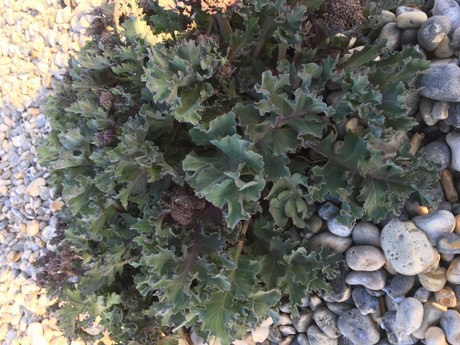Sea kale lives up to its name. It grows as easily as kale. This means the market can grow along with it. It is one of the few vegetables that are freshly available in the Netherlands in winter. In the coming months, this delicate variety of ocean vegetable will be available for a short time. This makes it a real seasonal product.
"It will be available until about May or June," estimates Hans Elenbaas of the Dutch company, Elenbaas Zeegroenten. “This depends on the weather and the influence this past hot, dry summer had on the product."
Grower, Jean-Pierre van Wesemael from the Dutch company, Saeftinghe Zilt, and Elenbaas Zeegroenten's Hans Elenbaas. Here, they are standing at the sea kale's cultivation boxes.
Grower, Jean-Pierre van Wesemael works at Saeftinghe Zilt. In 2006, He was the first to cultivate sea kale in the Dutch province of Zeeland. As this product name indicates, it grows in the Dutch coastal areas. It can also be found in Belgium, France, England, and Denmark.
Sea kale's roots are not permanently in the sea water. It grows in the so-called 'splash water zones'. Nowadays, sea kale can also be found in places along the slopes of the Zeeland sea dikes. Jean-Pierre has managed to establish a commercial crop. He did so by constantly increasing his crop's sparse parent material. He does not need to use any pesticides to grow his sea kale.
At Saeftinghe Zilt, they have managed to start cultivating sea kale.
The supply of sea kale usually starts in December. Demand is at its highest in that month. "However, the dry summer meant cultivation started a little later," says Jean-Pierre. "The product's quality is, however, perfect," The current crop can be compared to chicory or forced rhubarb. In the past, people living in the coastal areas already forced the growth of these wild plants.

Wild sea kale on a pebble beach. Only the young shoots are good to eat.
“Sea kale grows naturally mostly near the flood line on pebble beaches or sea dikes. It grows into a plant during the summer months. The plant's tough leaves are not very good to eat", explains Jean-Pierre.
"The leaves die in the winter, and the roots absorb the valuable nutrients again. During this time, people would cover them up with large stones. They did so to prevent the sea kale from getting any light."
"They could then pick the first, tender, purple shoots. These appear in spring. They then allowed the plant to grow out into a fully-grown plant again. In this way, the cycle could start anew," he says.
A sea kale root, seen after years of propagation from the first sea kale plants obtained in 2006.
Wild sea kale is currently endangered. It may no longer be harvested. Jean-Pierre has, however, managed to cultivate the delicacy. He did this by introducing salt water into outdoor cultivation. He then mastered the art of this sea vegetable's unlit indoor cultivation.
"It is completely different to growing potatoes, which we also do. Potato cultivation is very mechanized. In this type of cultivation, there is far more hands-on work," continues Jean-Pierre.
Through the years, Jean-Pierre has managed to double the number of sea kale plants he has. This sea vegetable's roots can be obtained through outside cultivation. This cultivation area is now 1 hectare in size. The indoor cultivation of these roots takes up about 100m2.
A lot of manual labor is needed for both the cultivation as well as the processing of this product.
Jean-Pierre's raw harvest of seal kale is sorted and trimmed at Elenbaas Zeegroenten. This company also puts the sea kale in protective, yet permeated packaging. The product can then last for between 10 and 14 days.
Hans says, "We are now at a production level of 55 to 60kg per week. A lot of this sea kale is sold to restaurants, and then especially in Belgium. Belgians love this product."
The raw harvest, being sorted at Elenbaas Zeegroenten.
Contrary to what the name suggests, sea kale is not salty. "It has a full, fresh flavor. Some people think it tastes similar to asparagus while others taste a radish-like flavor, without the sharpness," explains Hans.
"The stalks can be eaten raw, cut into thin strips. Or they can be briefly stir-fried in some oil or butter. Blanching is a great way to prepare the larger parts of the stalk. It is important that the stalks be fresh and crunchy. They must also not contain any stringy bits."
"We have a good, mutual partnership with Saeftinghe Zilt. This collaboration has been in place for years. Thanks to this, we can continue providing a good product," Hans concludes.
Workers at Elenbaas Zeegroenten sort and trim the sea kale stalks to size. It can then immediately be processed.
Sea kale can be bought per kg in 100g boxes. Ten of these boxes can be packed with outer packaging. They can also be packed, loose, in a box. This sea vegetable must be kept refrigerated between two and seven degrees Celcius.
This product's ideal storage temperature is at three degrees Celcius. Sea kale should also, preferably, be stored in the dark. If not, it will discolor.
Sea kale is carefully packaged using perforated material.
Hans: "In the near future, sea kale will be available in sufficient quantities."
For more information: Hans Elenbaas
Hans Elenbaas
Elenbaas Zeegroenten B.V.
14 Ampereweg
4338 PT Middelburg
The Netherlands
+31 (0) 118 602 200
+31 (0) 651 122 106
www.zeekraal.nl
